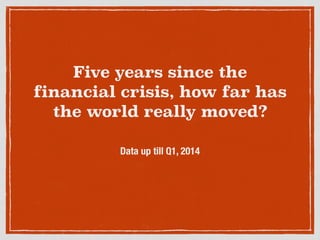5 Years since the financial crisis, how far has the world really moved?
- 1. Five years since the financial crisis, how far has the world really moved? Data up till Q1, 2014
- 2. How did the 2008 crisis precipitate? The bubble in U.S. housing market had to ’¼ünally end in early 2006 ŌĆ” ŌĆ” new construction stuttered; into a tailspin rapidly declining to 50% of peak activity ŌĆ” ŌĆ” Securities linked to real estate started plummeting ŌĆ” Chart source: U.S. FED
- 3. Sep 15, 2008: Lehman filed for Chapter 11 Lehman closed its doors with over $600 billion in debt; largest in U.S. history.
- 4. ŌĆ” from its peak in Oct 2007, S&P 500 fell over 55% by Mar 2009ŌĆ” Chart source: Google ’¼ünance Equity Markets crashedŌĆ”
- 5. Chart source: U.S. FED US economy saw the worst ever contraction since the great depression of 1930s
- 6. Real GDP growth rates for 2009. Countries in brown were in recession ŌĆ” the ’¼ünancial crisis spread rapidly. Many of the world economies went into recessionŌĆ” Chart source: CIA Fact book
- 7. 5 years since the crisis.. LetŌĆÖs take stock of how far has the world moved? 14 14.5 15 15.5 16 2005 2007 2009 2011 2013
- 8. United States LetŌĆÖs start with US, epicentre of the crisis
- 9. Usual GDP growth chartŌĆ” says very little about how far has the US economy moved Can only infer the US economy contracted till the Q4 2009.
- 10. Q1 2008 Q2 2008 Q3 2008 100 Baseline 2007 101 100.9 99.7 97.2 97.6 96.8 Q4 2008 Q1 2009 Q2 2009 Use a technique called indexation to see the cumulative effectŌĆ” track for each quarter starting from Q1 2008 Above chart explains by Q2 2009, the US economy is at 96.8 scale of Q2 2007 level of activity - contraction of 3.2% from the base year Note: this method introduces some errors, but charting over 25 quarters, the errors are minimised
- 11. So, how far has the US economy really moved? By Q1 2014, the cumulative growth is 7.4% over Q1 2007 (Indexed Growth 107.4 over 7 years)
- 12. LetŌĆÖs include the other developed economies United States Japan Germany France United Kingdom Italy
- 13. Now with the developed economies mixŌĆ” Starkly different growth patternŌĆ” An easy to read table in the next slide
- 14. A table is easier to read, sometimes.. 3 Bands of performance Top Pack: US: 7.4% Germany: 6.8% Middle Pack: Japan: 2.5% UK: 2.2% France: 1.7% Bottom Pack: Italy: 8.7% contraction Qtr US_idx Germany_Idx Japan_Idx UK_Idx France_Idx Italy_Idx 01-Jan-14 107.4 106.7 102.5 102.2 101.7 91.3 01-Jan-14 7.4% 6.7% 2.5% 2.2% 1.7% -8.7%
- 15. There is another in’¼éuential pack: The BRICs Brazil Russia India China
- 16. This is how the BRICs performed Better than developed markets, but again widely different performance
- 17. For those who like tables (need to do better charts :) ) 2 Bands of cumulative performance Top Pack: China: almost doubled its size India: added more than half of its 2007 size Middle Pack: Brazil & Russia Qtr China_idx India_Idx Brazil_Idx Russia_Idx 01-Jan-14 180.3 158.5 123.3 114.1 01-Jan-14 80.3% 58.5% 23.3% 14.1%
- 18. How many countries makeup 65% of World Economy?
- 19. What is T10? Group Country/Region $ Billion Share World 74,900 DM-6 United States 16,800 Japan 4,902 Germany 3,635 France 2,735 United Kingdom 2,522 Italy 2,071 Total 32,665 44% BRICs China 9,240 Brazil 2,246 Russia 2,097 India 1,877 Total 15,460 21% Top 10 Economies 48,124 64% Next 10 Economies (11-20) 15% 2013 Nominal GDP Data T10 economies contribute 64% of world economic activity. China and India are the fastest growing among T10 Top 10 Economies by size = Top 6 Developed Economies + BRICs
- 20. Purchasing Power Parity Purchasing Power Parity (PPP) is a better approach to compare economic output of nations For a representative basket of goods the prevailing price in a nation is collected and used to estimate the conversion rate between the nationŌĆÖs currency and the US $.
- 21. Top 10 economies by PPP Rank GDP (PPP) $ Billion World 1,01,887 1 United States 16,800 2 China 16,158 3 India 6,774 4 Japan 4,624 5 Germany 3,493 6 Russia 3,461 7 Brazil 3,012 8 France 2,437 9 Indonesia 2,388 10 United Kingdom 2,321 Share of World 61,468 60.3% BRICs Total 29,405 29% World Bank Estimate for 2013 Why BRICs still matter? BRICs (4 countries) contribute to 29% of world economic activity by PPP.
- 22. Some more slides on the way charting other aspects :) How far has the world really moved since the crisis?





















